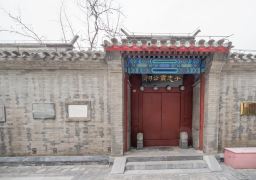Baiyun Village is the place where Huang Zongxi, the founder of the famous Zhe Dong School in the late Ming and early Qing dynasties in China, gave lectures. It is located near Guanjin’an Bank in the western suburbs of Ningbo urban area. Originally, it was the tomb manor of Wan Tai, the chief official of the Ministry of Revenue in the late Ming Dynasty. Because his son Wan Sixuan was called ‘Mr. Baiyun’ and was buried here after his death, it is named Baiyun Village. In 1668, the seventh year of the Kangxi reign of the Qing Dynasty, Huang Zongxi was invited by Wan Tai and others to come to Ningbo to give lectures. For a time, celebrities gathered and literati gathered. The style of learning in Siming suddenly flourished. At first, the lecture site was set in Wan Tai’s house on Guangji Street. Later, it was moved to Yanqing Temple and called Zhengren Academy. Two years later, it was moved to Baiyun Village again. After being renovated, Baiyun Village is surrounded by high walls. Inside the village, there are graceful bamboos and green grass everywhere. The environment is simple, elegant, quiet and profound. The main building faces east. The gate of the Ming Dynasty. The lintel of the second gate is inscribed with regular script ‘Ningbo Zhengren Academy’ (also known as the lecture place of Mr. Lizhou) and ‘Baiyun Village’ respectively. Inside Baiyun Village, there is the former residence of Wan Sitong, the life story of Huang Zongxi and the exhibition of the main figures of the Zhe Dong School and their influences. To the west of the exhibition room and the former residence is the Wan family (Wan Bangfu, Wan Sixuan, etc.) cemetery. Among them, the tomb of Wan Bangfu, a Ming governor, is very large. Opening hours: Open from 8:00 to 18:00 all year round.
Baiyun Village
Baiyun Village is the place where Huang Zongxi, the founder of the famous Zhe Dong School in the lat[...]









